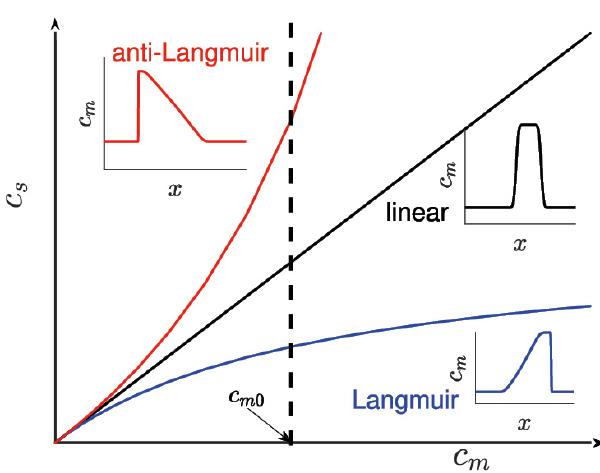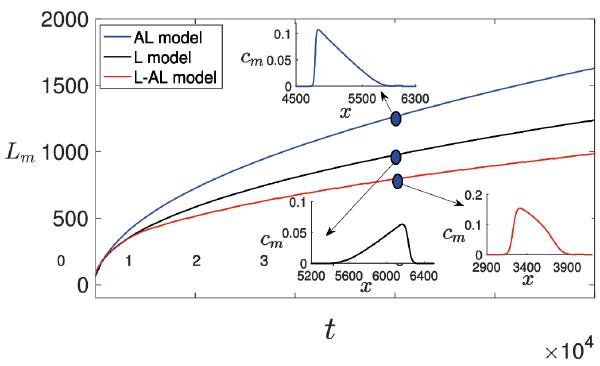In the same section
-
Share this page
Implementation of alternating langmuir and anti-langmuir zones in chromatography columns [Technology offer]
The technology in a nutshell
New tool to separate compounds in high performance liquid chromatography by alternating langmuir and anti-langmuir zones along the column.
State of the art
The most versatile and powerful technique for the separation of key compounds in the pharmaceutical industry is liquid chromatography. A limitation of this technique is that high efficiencies can be obtained only for low sample concentrations. For high concentrations leading to overloading, an undesired concentration shock arises, which will either broaden the component zone downstream (Langmuir or L-behavior)
or upstream (anti-Langmuir or AL behavior).
In chromatography, analytes need to be in selective interaction with a stationary phase. When there is insufficient surface on this stationary phase, the analytes migrate downstream the channel in the mobile phase until a free interaction site is found. Because the migration distance is longer under overloading conditions, considerable dilution occurs compared to a non-overloading situation, resulting in a non-symmetrical peak either at the right (Langmuir) or the left (Anti-Langmuir) of the (space-based) peak (Fig. 1).
This sample band gets wider and wider until the concentration has dropped to a value at which sufficient interaction surface is available.

Fig. 1: Characteristic sample band profiles for different stationary phase concentration (cs)-mobile phase concentration (cm) equilibrium values
The invention
The core of the invention is to alternate Langmuir and Anti-Langmuir zones along the column (Fig. 2) so that the steeper concentration front is periodically moving up- and downstream the center of the peak (in an accordion fashion), thereby limiting overloarding dispersion.

Fig. 2: implementation of L-AL zones in the column
Two different types of stationary phases with respectively L and AL adsorption properties have to be incorporated in the column alternatively in space to achieve this effect. Simulations have indicated that an increase in performance by a factor of 2 can be obtained (see Fig. 3 for a representative result).
Such a decreasing in dispersion allows to generate much higher concentrations and purity of the separated streams.

Fig. 3: Reduction in band width (Lm) for the
alternating L-AL approach.
Key advantages of the technology
- Separation and purification with higher final concentration
- Higher throughput for preparative separation
Potential applications
- Pharmaceutical industry
- Biotechnology
- Food-water-environmental control
Techology Readiness Level

The team
Prof. Wim De Malsche, μFlow group, Department of Chemical Engineering, VUB : combining our know-how on chemical engineering and precision and micro-machining technology, our group is ideally positioned to develop novel devices and processes in the area of microfluidics and microreactor technology.
Prof. Anne De Wit, Non-linear Physical Chemistry unit, ULB : our group is devoted to the theoretical study of spatio-temporal dynamics of physicochemical systems resulting from reactions coupled to transport processes (diffusion, convection) or phase transitions.
Relevant publication
- Decreased peak tailing during transport of solutes in porous media with alternate adsorption properties, Rana, C., De Malsche, W.,De Wit, A. (2019), Chemical Engineering Science, 203, 415-424.
Keywords
- Preparative chromatography
- HPLC
- Concentration overloading
- Dispersion minimization
- Plug flow reactor
Collaboration type
- Licence agreement
- R&D collaboration
IP status
- Priority data: EP20180195681 filed on September 20th, 2018
- PCT application: WO2020058496 (A1) published on March 26th, 2020
Inventors
- Pr Wim De Malsche
- Pr Anne De Wit
- Dr Chinar Rana
Contact
ULB Research Department
Joachim Ruol
Business developer
+32 (0)2 650 30 67
joachim.ruol@ulb.be
